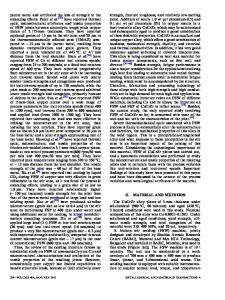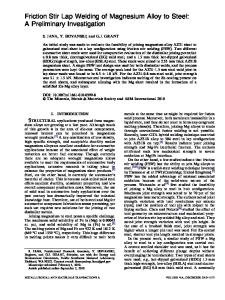Influence of Welding Temperature on Material Flow During Friction Stir Welding of AZ31 Magnesium Alloy
- PDF / 6,141,522 Bytes
- 9 Pages / 593.972 x 792 pts Page_size
- 94 Downloads / 368 Views
ICTION stir welding (FSW) is a relatively new solid-state joining technique having significant industrial potential. Basically, FSW involves a plunging of a rapidly rotating welding tool between two butted sheets and its subsequent traverse along the joint line. Due to the frictional heating as well as plastic deformation induced by the rotating tool, the local temperature of the welded material raises so it can be deformed at relatively low stress. Accordingly, the hot material flows around the tool, fills the cavity at its rear, and thus forms a solid-state joint. The welding tool typically has a mushroom-type design and consists of a relatively large
S. MIRONOV is with the Belgorod National Research University, Pobeda 85, Belgorod, Russia, 308015. Contact e-mail: [email protected] Y.S. SATO is with the Department of Materials Processing, Graduate School of Engineering, Tohoku University, 6-6-02 Aramaki-aza-Aoba, Sendai 980-8579, Japan. H. KOKAWA is with the Department of Materials Processing, Graduate School of Engineering and also with the School of Materials Science and Engineering, Shanghai Jiao Tong University, 800 Dongchuan Road, Minhang District, Shanghai 200240, P.R. China. Manuscript submitted November 4, 2018.
METALLURGICAL AND MATERIALS TRANSACTIONS A
shoulder and a relatively small threaded probe. Further details of FSW are available in recent reviews on the subject.[1–3] The feasibility of FSW for material joining and service properties of produced welds are believed to be essentially influenced by material flow during welding. Accordingly, this issue has attracted significant interest. An extensive research has conclusively demonstrated the remarkable complexity of this process. Its principal characteristics are briefly reviewed below. Due to a specific character of FSW process, the stirred material normally experiences a combination of rotational and translation motions. In order to improve material mixing, however, the material may additionally be forced to flow along the height of the welding tool. This effect is usually achieved by the probe threading which promotes downward material transportation and the respective upward extrusion of excessive material.[1–3] As a result, the stirred material is thought to follow a very complex helical trajectory. Moreover, considering the characteristic design of the welding tool, the material motion is well accepted to be essentially different in the upper portion and remaining parts of the stir zone. Specifically, the material flow in the near-surface layer is governed by the tool shoulder, whereas that in the bulk stir zone is driven by the tool probe.[4,5] In both cases, the imposed strain is close to simple-shear deformation,[6–10] but the shear occurs
either along the shoulder plane or the probe surface. In the transition zone, interaction between these two motions may result in chaotic material flow.[1] Under some circumstances, however, such interaction may also give rise to a macro-scale effect at which the shear plane lies between the shoulder surface and the
Data Loading...











